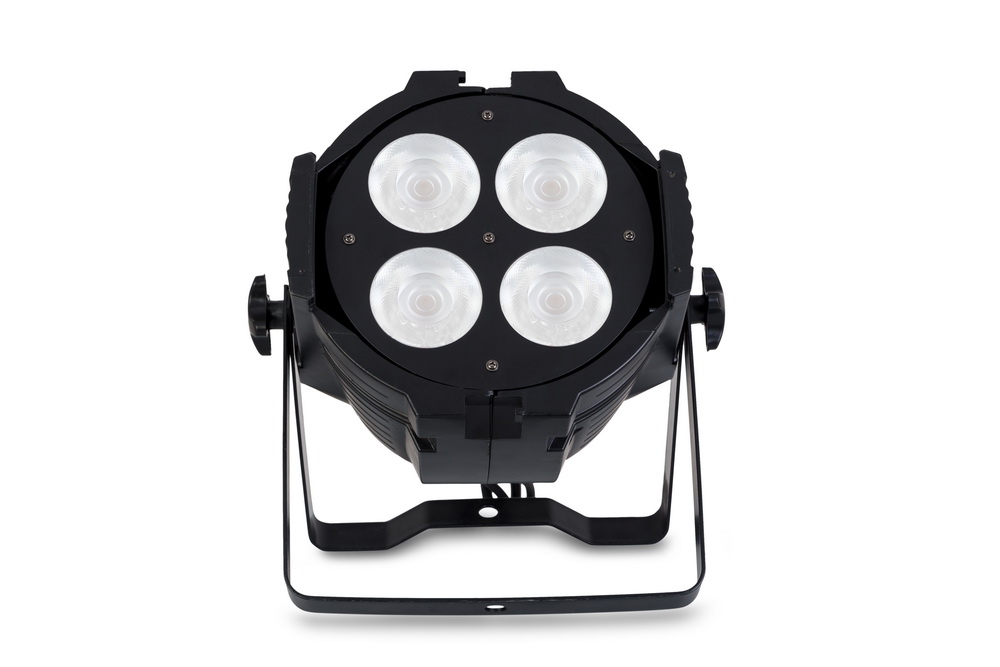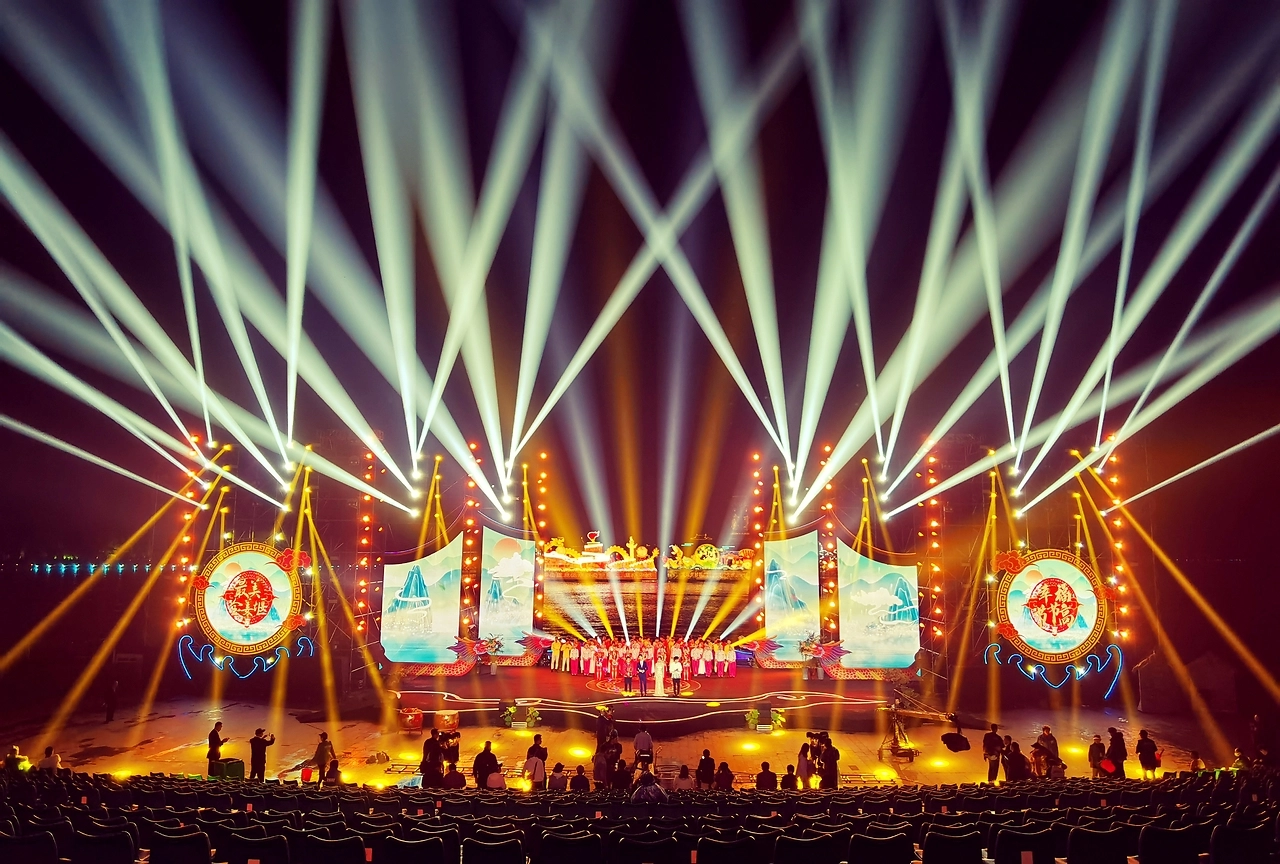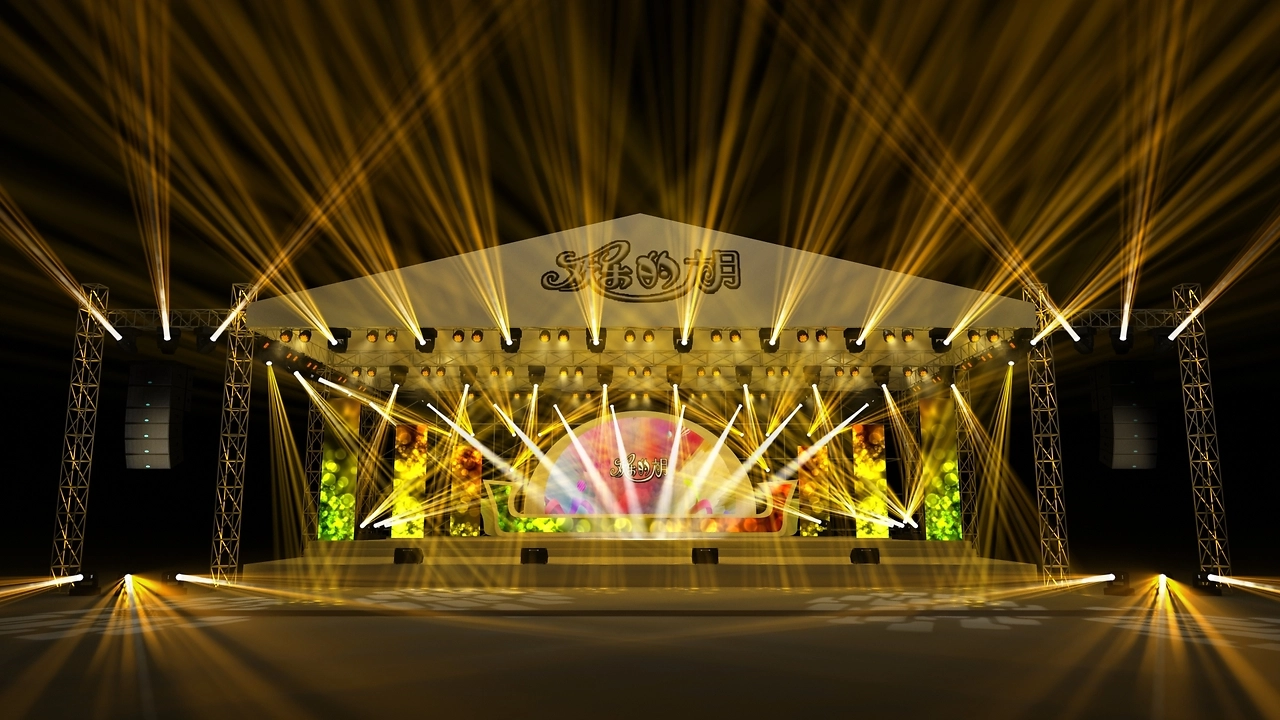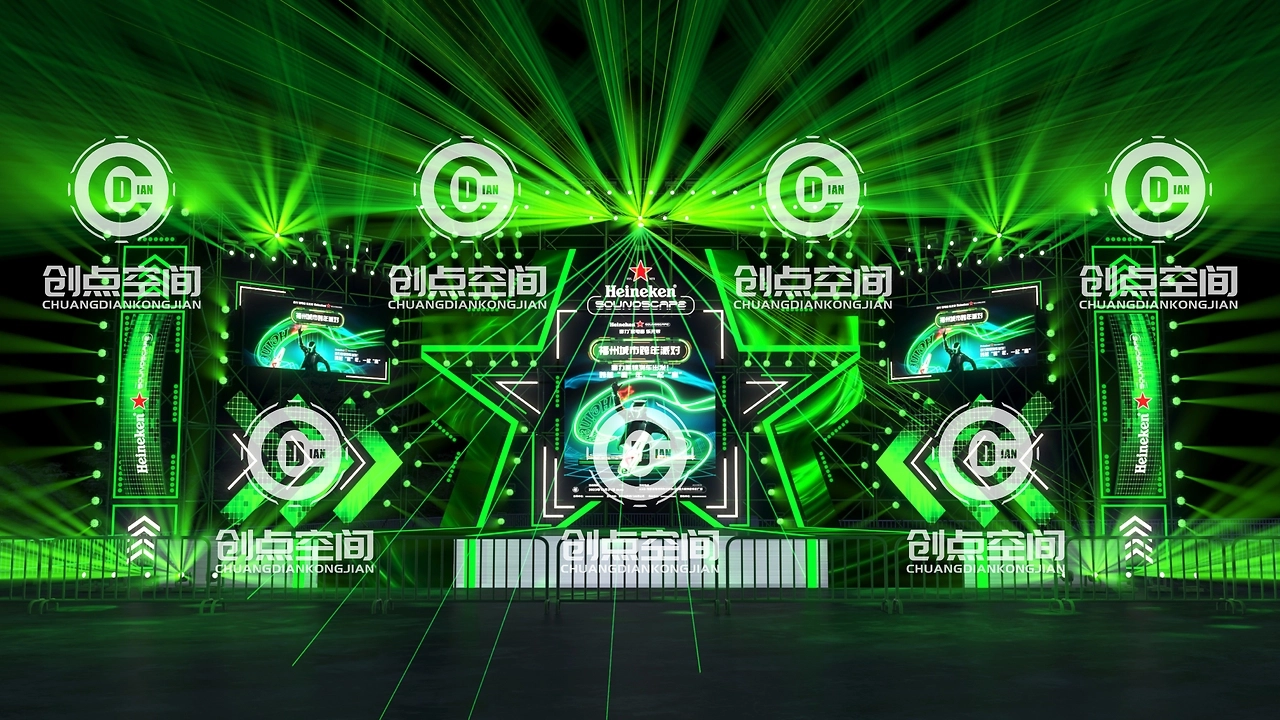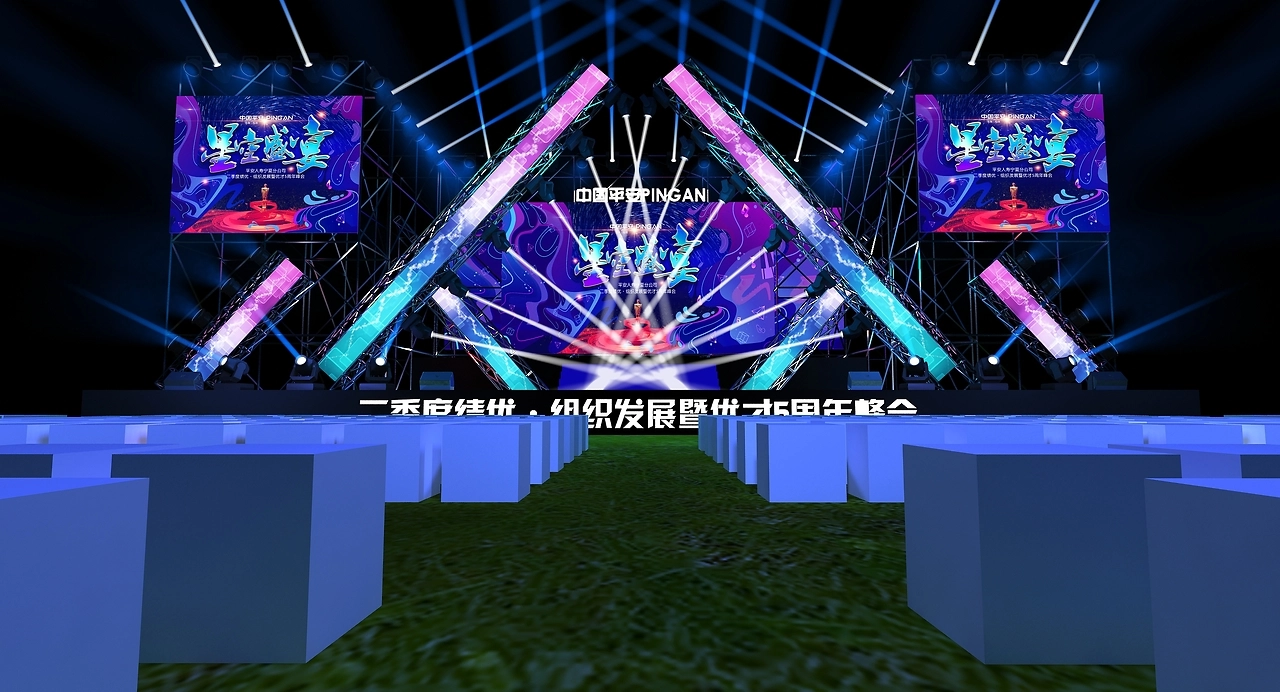The functional requirements for the use of the performance stage lighting system are to meet the needs of various comprehensive performance activities, ensure the lighting for large and medium-sized conferences, and meet the requirements for live television broadcasting and recording. We have designed the overall performance stage lighting scheme based on this functional positioning. We fully consider the coordination between lighting, stage machinery, and other related professions in stage lighting design, ensuring technically that the performance stage becomes a first-class performance venue in China. Pursue economy, progressiveness, security and scalability on the premise of ensuring practicality. The overall lighting system design, configuration, and layout of the performance stage are designed to meet the requirements of various artistic performances, and the lighting of the entire stage is scientifically, reasonably, and coordinated. The stage lighting layout is divided into inner and outer areas, equipped with basic light positions that can be flexibly adjusted to meet the needs of functional purposes such as performances. In stage performances, lighting usually consists of top light, face light, side light (column light), slap light, backlight, overseas light, auxiliary light, and other parts. Commonly used lighting includes imaging lights, pattern lights, sky and earth row lights, moving head beam lights, dye bar lights, laser lights, chasing lights, and so on.
Whatsapp:+86 134 1860 8878
When designing the signal control network system, I fully understood the design ideas of the stage lighting designer for the performance, and drew heavily on the successful experience of newly built stages in China. I have a very deep understanding of the requirements for lighting control, and the overall design concept is comprehensive and thoughtful, with a reasonable layout. In order to meet the above performance functions, the stage lighting system design scheme must achieve:
Whatsapp:+86 134 1860 8878
1. The stage lighting system should be advanced, practical, and safe, and the design should meet the requirements of owner management;
2. The working mode of the stage lighting system should be coordinated with the lighting mode of the audience seat, and its light color, brightness, and scene control should be designed uniformly;
3. Each dimming or direct circuit should not be less than 6KW, and the output power can be set; The communication protocol of the control system adopts TCP/IP or DMX512 protocol;
4. To provide as many projection positions as possible, each stage position should have at least three or more projection angles in different directions, creating a three-dimensional sense of light and preventing glare, reflected light, and useless spots;
5. The lighting control system ensures absolute safety and reliability in performances and events as the fundamental requirement. By adopting mature technology, products, and the latest processes, the technical level, performance, and parameters of the lighting control system have reached the international advanced level.
Whatsapp:+86 134 1860 8878
6. The selected lighting system control equipment takes into account the usage habits of domestic and foreign performance groups and lighting technicians; The system can be compatible and connected to various lighting control devices from all manufacturers and different communication protocols.
7. According to the principle of "leaving room for excess", design and equip all lighting equipment and network devices to provide a sustainable upgrade and expansion equipment system platform for future technological development of the lighting system.
8. Choosing professional stage lighting fixtures should have high color rendering, meet the requirements of stage lighting that cannot distort the colors of leaders' clothing and stage scenery, and meet the color temperature requirements of lighting sources for television recording or broadcasting.
Outdoor Stage Lighting Design Description
1、 Design Basis
According to the needs and requirements of Party A and the information provided
JG/J-57-2000/J67-2001 "Design Code for Stage Buildings"
JG/J16-2008 "Code for Electrical Design of Civil Buildings"
GB/J16-92 (revised in 1995) "Code for Fire Protection Design of Buildings"
GB/T50314-2000 "Design Standards for Intelligent Buildings"
GB/T50311-2000 "Code for Design of Integrated Cabling Engineering for Buildings and Building Clusters"
GB/T50312-2000 "Code for Acceptance of Integrated Cabling System Engineering for Buildings and Building Clusters"
GB/50259-96 "Code for Construction and Acceptance of Electrical Lighting Equipment in Electrical Installation Engineering"
GB/50169-92 "Code for Acceptance of Construction Quality of Grounding Devices in Electrical Installation Engineering"
GB/J232 "Code for Construction and Acceptance of Electrical Equipment Installation Engineering"
GB/50300 Unified Standard for Construction Quality Acceptance of Building Engineering
GB/50303 "Code for Acceptance of Construction Quality of Building Electrical Installation Engineering"
GB/50057 "Code for Design of Lightning Protection of Buildings"
GB/T14549/93 Power Quality, Harmonics in Public Power Grids
GB/T126661/6/90 Fire resistance assessment standard for cables
GB/50217/94 Cable Design Specification
GB/50258/96 Cable laying specifications
GB/T15734-1995 "Limits and measurement methods for radio disturbance characteristics of electronic dimming equipment"
GB/T7002-86 "Luminous Testing of Projection Lighting Fixtures"
GB/7000.14-2000 "Safety Requirements for Ventilated Luminaires"
GB/7000.15-2000 "Safety Requirements for Stage Lighting, Television, Film and Photography Places (Indoor and Outdoor) Lighting"
In order to meet the performance oriented function, the design scheme of the stage lighting system must follow the following five design principles: safety and reliability, high visibility, energy conservation and environmental protection, progressiveness and scalability.
1. Security and reliability (dual backup of fiber optic backbone network and main control equipment)
Safety is an eternal and unchanging topic, and it is the most basic guarantee condition required for high-performance stage professional lighting systems. This design plan will ensure the requirements from the following two aspects.
1.1 Control system equipment
As the throat of the lighting system, the stability and reliability of the control system equipment will directly affect the normal operation and performance of the entire system. Therefore, configuring stable and reliable control equipment is a prerequisite that must be considered. In the design scheme, fiber optic network intelligent dimming cabinets, straight through cabinets, computer light control consoles, and professional network dimming consoles are selected.
The fiber optic network intelligent dimming/straight through cabinet has anti-interference capability that meets the national first level standard, multi-level overcurrent/short circuit protection measures, and three signal interfaces of fiber optic, Ethernet, and DMX. It can report three-phase current, voltage, fan operation, and various circuit parameters (current, voltage, temperature, and switch status) to the network system, and has signal power-off protection function, which does not affect the execution of signal instructions and ensures the safe and reliable operation of the system.
The computer light console and professional dimming table work stably and reliably: they are stored on both electronic hard drives and USB drives, with network backup function, which can back up data to designated PCs and work online with the main and auxiliary stations. The auxiliary station continuously tracks the main station to achieve seamless switching; Real time viewing of dimming cabinet status and data locking to prevent accidental modifications. It has functions such as field, centralized control, effect, group, color changer control, macro, curve, report, and viewing, and can be edited and modified. It also has manual field and light cutting functions;
1.2 Signal transmission system
The stability and reliability of the network transmission system are necessary conditions for smooth and secure transmission of lighting control signals. The system network architecture adopts fiber optic Ethernet as the backbone communication network.
Using multimode fiber as the main communication medium, it has long transmission distance, fast speed, and strong anti-interference ability. Overall, the design of the entire lighting system scheme should have multiple safety, stability, and reliable system guarantee measures; And future system upgrade requirements.
1.3 High visual acuity
The stage lighting system will meet the requirements of the meeting from four aspects: illumination, color rendering, color temperature, and glare, creating a good visual lighting environment for the meeting.
Illumination index: The average illumination of the stage is not less than 1200LUX, and the brightest area in the center can reach 1500LUX; Relative to any position within the stage area, there should be no less than three directions of light, and the maximum average illuminance of white light in each direction should not be less than 1000 LUX;
Color rendering index: Ra>90;
Color temperature: Stage lighting fixtures have a color temperature of 3200 ± 150K during meetings and 5600 ± 500K during performances.
Glare: Special attention should be paid to preventing glare on stage. The generation of glare is directly related to the projection angle of the lighting fixtures, especially in the position of the face light, slap light, and fake stage mouth. Therefore, the projection angle of the lighting fixtures should be controlled between 30-60 degrees. The most ideal angle for this plan is 45 degrees.
1.4 Energy saving and Environmental Protection
Incorporate operational management and cost factors into every design stage. Advanced technology, energy-saving, and environmentally friendly system equipment are selected, and a large number of tricolor cold light sources are used as the main lights for performances. Their characteristics are high efficiency, low energy consumption, high brightness, low temperature, and long service life. At the same time, building a modern hardware platform for stage management to achieve efficient and low-cost operational goals.
1.5 progressiveness of the system
Based on the fact that the stage lighting system can meet the main function of performing, this design scheme adopts the following four advanced technologies:
Using high color rendering stage lighting fixtures;
Adopting a lighting console with powerful control and editing functions;
Adopting intelligent fiber optic network dimming/straight through cabinet;
Using fiber optic as the main communication network ensures that the system is foolproof.
The stage lighting network control system is an integration of a new generation high-speed network and intelligent digital control equipment, using a design that combines fiber optic Ethernet and DMX512. This dual signal coexisting data transmission system not only meets current usage requirements, but also leaves ample room for future system upgrades and expansion. By utilizing the high-speed and large capacity characteristics of fiber optic cables, Ethernet achieves high-speed transmission with strong scalability, and based on the fact that most equipment on professional stages currently uses DMX512 signal control, multiple signal transmission methods are scientifically integrated into a unified mixed signal transmission network, directly delivering network signals to each user point, making the stage lighting system have good development potential and openness to meet the needs of high-speed and effective signal transmission, system expansion, and continuous technological upgrades.
1.6 System Scalability
Design a comprehensive and stable stage lighting system, which should not only have excellent lighting configuration, but also consider the compatibility and scalability of the selected equipment. Due to the continuous development of technology and the emergence of new devices, the design and installation of each project cannot always be the most advanced and perfect. However, in our design, we have fully considered the expansion requirements of the system in the future. Reflected in the following three aspects:
Dimming/straight through cabinet: Adopting a unified output standard, the rated output power of each circuit is 6KW, and the output size can be set to improve the safety of the equipment. The control system adopts the same data format, which can be replaced or controlled simultaneously, greatly facilitating lighting designers.
Communication protocol: The underlying protocol of the stage lighting control system is the internationally recognized DMX512 protocol. Most digital consoles, dimming/straight through cabinets, computer lights, LED lighting fixtures, and other digital devices can operate stably on the stage lighting system network.
Standardization of equipment accessories: The main equipment of the system complies with national standards and achieves IS9001 international quality certification. The system design, pipeline selection, and supporting construction comply with relevant national industry standards or specifications. The selection of connectors and wires should ensure safety, reliability, and durability, and comply with national quality standards or corresponding electrical and related standards.
2、 Engineering Implementation Instructions
2.1 Design Overview
The engineering design of stage lighting must meet the requirements of light zone control, light color control, and light quantity control. The organic combination of the three is a prerequisite for producing stage lighting with aesthetic value in the performance space.
Light zone control - the control of the lighting area for performances, with the aim of using light to control the audience's attention and purposefully guide them to view the performance object. And create variable performance spaces according to the plot needs.
Light color control - the control of the display of light colors, with the aim of creating a visual experience of color for the audience based on people's physiological, psychological characteristics, and associations with life, combined with the plot and creating a color atmosphere.
Light intensity control - the control of changes in light intensity, with the aim of utilizing the changes in light intensity to adjust the artistic effect of light, and to better achieve spatial brightness and darkness effects in changing the sense of time and space, cutting plot segments, and other aspects.
Stage lighting is the soul of stage art, and perfect lighting configuration and application are necessary conditions for successful performances. Stage lighting, in summary, needs to highlight its characteristics from four aspects:
Freehand brushwork - to enable the audience to see the scenery on stage well, that is, to correctly understand the creative intention of drama and dance.
Realism - making the stage look like real life scenery, that is, the authentic reflection effect of lighting.
Aesthetics - To present the stage beautifully and give the audience a refreshing and pleasing feeling that matches the scene.
Performance - To render the thoughts and emotions of drama, dance drama, etc.
These are all highlighted by harmonious lighting. However, in order to achieve a clear visual effect on stage, it is not only necessary to have a reasonable illuminance, but also a uniform illuminance distribution. Therefore, a reasonable illuminance and its uniformity are the basic conditions for ensuring object visibility. To solve this problem, we use the ratio of the maximum illuminance value to the minimum illuminance value or its reciprocal to control it, which is approximately within the range of 3:2 or 2:1.
2.2. Distribution of Stage Lighting Circuits
The design of stage lighting circuits is a key focus of stage lighting design, as good design can provide artistic creation space and flexible lighting technology support for lighting creators during performances outside of the venue. That is to say, lighting circuits should be designed for all possible lighting positions on the stage, and these circuits should be allocated reasonably and scientifically.
The large stage requires technical performance to be able to simultaneously light multiple leaders in the entire stage area or multiple actors in the same performance area, and the brightness, color temperature, and color of the lighting can be flexibly adjusted. The lighting arrangement can achieve satisfactory projection angles for any area, thereby realizing multi-directional and multi angle lighting, providing necessary technical conditions for creating ideal performance environments and artistic effects.
1. Surface light configuration instructions
As the main front light of the performance area, the surface light is mainly used to illuminate the front performance area of the stage, playing a positive lighting role for performers on the stage, for character modeling or to present three-dimensional effects on objects on the stage. According to the projection distance, the lighting is arranged to ensure that the projection effect of the surface light is achieved, with uniform light spots and consistent illumination.
Arrangement and projection method of lighting fixtures:
Vertical projection: achieving a uniform effect below the stage performance area;
Cross projection: Enhance the brightness of the central area and depth of the stage;
Key projection: Strengthen the lighting of local stage performance areas.
2. Face slapping configuration instructions
The lighting from the slap rooms on both sides of the stage audience seats is directed towards the stage as a diagonal directional shaping light in front of the stage, to enhance the three-dimensional sense of characters and scenery, and create a lighting effect on the front and side. The projection angle of the slap should be lower than that of the face light, and the projection distance should be closer than that of the face light. The lighting requirements should be similar to those of the face light. The projected light beam cannot overflow beyond the platform.
Slapping is an auxiliary light for facial recognition, used for character styling;
The stage color atmosphere can be rendered from one or both sides;
Cross projection of outer and inner lights can achieve a larger projection range;
When two or more rows of slaps with the same light color are projected simultaneously, the higher positioned light usually projects the high beam area, while the lower positioned light usually projects the low beam area.
3. Side light configuration instructions
The function of side lighting is to create a sense of direction for the light source from the side of the stage, creating a sense of hierarchy and three dimensionality for the leaders or actors on stage. It can be used as auxiliary lighting to illuminate the actors' faces and enhance the level of the scenery, rendering the characters and stage space environment. Factors such as the angle, direction, distance, type of lighting fixture, and power of the projected light can cause various side lighting effects.
Arrangement and projection method of lighting fixtures: The emission distance of side lights varies greatly from near to far, and the projection angle varies greatly from near to far. The styling light from one or both sides can emphasize and highlight the contour of the side, suitable for expressing volume effects such as reliefs and characters. Unilateral light can exhibit a relatively strong effect of yin and yang. Bilateral lighting can express personalized characteristics of plywood lighting, but it is necessary to adjust the light ratio between the front auxiliary lighting and the side lighting to achieve a more complete styling effect.
4. Column light configuration instructions
The column lights set on both sides of the stage curtain line are column lights, and the light is directed from both sides of the stage entrance towards the performance area; Mainly to compensate for the shortcomings of facial recognition and slapping, and can also serve as the main lighting requirement for the mid to back court performance area. The arrangement and projection method of lamps: The arrangement and projection method of lamps are basically the same as that of a slap.
5. Explanation of Light Configuration on Fake Platform
Set up lights in the upper area of the fake stage entrance within the stage curtain line, with light shining from the front of the area towards the stage area; Mainly to compensate for the lack of depth and surface lighting on the stage, it can serve as the main lighting requirement for the center and back stages of the stage. Arrangement and projection method of lighting fixtures: The arrangement and projection method of lighting fixtures are basically the same as that of surface lighting.
6. Top light and backlight configuration instructions
The top light is set up every 2.0m above the stage, and the power supply is suspended from the stage ceiling through multi-core cables. There are wire baskets on both sides of the light suspension rod to accommodate cables. The lamps are hung under the light suspension rod to provide necessary lighting for the performance space in the depth of the stage. The top light includes both forward and reverse lights, which can be stacked on the same lamp post. The lamps can be configured according to the needs of the performance.
Arrangement and projection method of lighting fixtures: The first top light is connected to the surface light to illuminate the main stage area, paying attention to the height of the characters when connecting; The following lines can be projected directly towards the back of the stage, vertically downwards, or as backlighting forward according to the plot needs; Thus enhancing the lighting of stage character design and scenery space. The front and rear lighting are connected to achieve a relatively uniform color and brightness in the stage performance area.
7. Explanation of Sky Discharge Light Configuration
Unlike ground mounted lights, sky mounted lights are light fixtures that scatter light from top to bottom, projecting and rendering colors towards the upper part of the stage canopy. They are usually used in conjunction with ground mounted lights to make color changes more diverse, and the lighting fixtures are used in combination with single lights. Arrangement and projection method of lighting fixtures: Rows of lighting fixtures are evenly placed in front of the stage canopy, used to project overhead and depict the horizon, horizontal lines, sunset, etc. They are usually used in conjunction with ground mounted lights to make the color changes more diverse.
8. Explanation of Ground Drainage Light Configuration
Unlike sky mounted lights, ground mounted lights are light fixtures that scatter light from bottom to top, projecting and rendering colors towards the lower part of the stage canopy. They are usually used in conjunction with sky mounted lights to make color changes more diverse, and the lighting fixtures are used in combination with single lights. Ground mounted light direction: Installed on the front panel of the canopy, 2.8m-3.5 meters away from the canopy.
Arrangement and projection method of lighting fixtures: Rows of lighting fixtures are evenly placed in front of the stage canopy to reflect the horizon, horizontal lines, sunset, etc. They are usually used in conjunction with sky lights to make the color changes more diverse.
9. Follow light configuration instructions
The lighting fixtures designed based on the principles of optical imaging and zoom have the ability to change the size, color, brightness, virtual and real of the aperture. They are installed on a specially designed bracket during performances to follow the movement of the actors and enhance their illumination brightness, improving the audience's attention. They can be set at various positions in the stage space to achieve local lighting effects on the actors' bodies, entire bodies, long distances, and small areas. Sometimes, chasing light can also be used to express abstract and illusory stage plots.
10. Computer Lamp Configuration Instructions
Intelligent lighting fixtures are an inevitable trend in the development of stage lighting in the 21st century. In order to meet various performance lighting needs, shaking head pattern computer lights and shaking head dyeing computer lights have been configured.
The integrated design of intelligent computer lights has higher stability than previous mechanized lights composed of multiple components such as electric motor frames, spotlights, color changers, shading plates, and special effect color discs. The CMY color mixing system in computer lights can produce over ten thousand colors, which is incomparable to general color changers; Various graphics and even slides can be projected using replaceable pattern sheets; When two or more pattern pieces overlap, they can create dynamic images with countless changes; Pattern based computer lights can use animation wheels to create various special effects such as movable water shadows, clouds, fire, rocks, etc. The remote control shading board can modify the shape of the light beam, allowing the light spot to be projected onto different backgrounds and props according to the lighting designer. The same lamp can quickly change settings to illuminate different objects. The computer lights have excellent functions and can greatly reduce the number of effect lighting fixtures on stage.
The computer lights are mainly arranged on the top light poles above the stage, connected to the computer console with DMX signals. The projection angle, brightness, pattern change, beam size, color and other functions of the lights can be adjusted freely, fully meeting the changing requirements of various performances for digital computer lights.
11. Other effect configuration instructions: In order to better demonstrate the performance effect, stage smoke machines, large double wheel bubble machines, and strobe lights are also set up on the stage to simulate real scenes in nature.
2.3 Stage Lighting Electricity Requirements
The total power capacity of the stage lighting power supply is _____ KW, the voltage is 380V, three-phase five wire system, of which the dimming circuit is _____ KW, and the direct circuit is _____ KW. In order to reduce interference, the total incoming line of the power supply is required not to cross the stage performance area.
2.4. Stage lighting equipment room: one stage lighting control room and one dimming silicon cabinet room.
2.5 Lighting Control Room
The lighting control room is a room used to control the stage lighting equipment. The stage lighting control room is arranged in the back area of the audience hall, with observation windows that can see the entire stage. The length of the observation window shall not be less than 3 meters, the height shall not be less than 1 meter, and the net height from the bottom edge to the ground shall be 0.8 meters. Indoor dimming station, color changer control panel, computer light control panel, etc. The room should be ventilated, cooled, insulated and anti-static flooring should be installed, and wiring ducts should be left. The net height of the room shall not be less than 2.5 meters.
2.6 Dimming silicon cabinet room
The dimming room is a supporting room for lighting control, and its location should be close to the lighting area and distribution room it serves. It should be equipped with distribution cabinets, silicon cabinets, or straight through cabinets. The length of the room shall not be less than 10 meters, the width shall not be less than 3.5 meters, and the net height shall not be less than 3 meters. Due to the large amount of heat generated during the operation of the dimming silicon cabinet, there is a need for forced heat dissipation equipment in the lighting control room.
The surface of the equipment base must be flat, and the surrounding area should be covered with 3mm thick patterned steel plates. The maintenance walkway and indoor floor on the cable trench should be fully covered with insulating rubber; The equipment bracket is made of steel material, welded firmly and smoothly as a whole, and treated with fire prevention.
2.7 Stage Lighting Construction Technology and Safety Measures(
